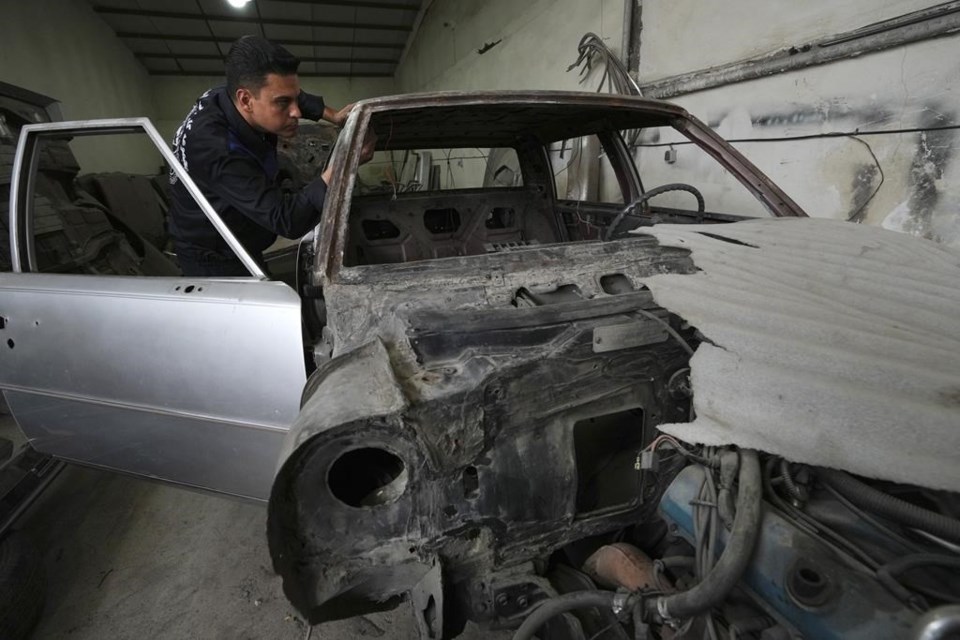TEHRAN, Iran (AP) — The sleek, polished dark blue 1978 Cadillac Seville eased slowly out of a showroom near Iran's capital, its driver carefully inserting the 8-track tape that came with it to blast the sounds of a time long since past.
The Sevilles, once assembled in Iran, represented the height of luxury in the country just before the 1979 Islamic Revolution. General Motors had partnered with an Iranian firm to build the sedans, selling them for two-and-a-half times the price in America at the zenith of the country's oil wealth.
Today, Khosro Dahaghin’s passion for restoring the cars means he carefully examines each frame, component and stitch of the Sevilles in Iran, a challenge that's only grown as parts become scarce, the vehicles get older and as the country faces U.S. sanctions over its nuclear program.
“The most luxurious and the most special car that was assembled in Iran was Cadillac Iran," Dahaghin told The Associated Press as he wore a necklace bearing the iconic Cadillac crest. "The first time this car was assembled outside U.S soil was in Iran. At that time I can say no other brand could rival this car in any aspect imaginable.”
To the uninitiated, the Seville may seem like a strange pick for a sought-after antique car with its almost boxy frame and wood-accented interior. However, it represented a sea change for Cadillac at a time when American buyers sought the smaller luxury cars coming from European manufacturers. Cadillac had been better known for the massive, finned cars of the past and the Seville’s fuel economy and handling caught the attention of drivers.
In the Seville, car buyers got a powerful, fuel-injected V8 engine, a pillowy interior, power seats and automatic door locks and windows. A base model Seville initially sold for $12,479 in 1975 when it entered the market — the equivalent today of over $70,000. General Motors produced nearly 57,000 Sevilles in the 1978 model year alone.
Back then, Iran had the only Cadillac production outside of the United States. GM created General Motors Iran Ltd., which produced the Seville and other vehicles from so-called knock-down kits from Detroit. The Seville represented the most luxurious vehicle on the road assembled in Iran, under the supervision of American engineers.
The Sevilles went for some $35,000 at the time they were introduced — more than what American consumers paid, in part due to higher import duties.
“As soon as they have the money, they want a pair of Levi’s and a car,” a General Motors official said of Iranians, according to a New York Times story about the Seville there in 1977.
How many were built remains a question among Iran's car aficionados.
Saeed Shobeiri, the editor-in-chief of Machine Magazine in Tehran, said estimates ranged as high as over 2,600. Michael T. Albano, a Cadillac spokesman in the U.S., said he believed some 2,500 were built.
But the 1979 Islamic Revolution saw the overthrow of the American-backed shah and the installation of Iran’s theocratic government. Americans and GM left the country. Sevilles continued to be built from the remaining knock-down kits for several more years as Iran nationalized the GM Iran plant, creating the manufacturer Pars Khodro that stills exists today.
GM ultimately was awarded some $20 million from the Iran-United States Claims Tribunal, set up as part of the Algiers Accords that saw the captives taken at the U.S. Embassy in Iran freed. Today, Shobeiri estimated as many as 60 Sevilles are street-worthy, with more than 100 others unable to be driven.
That's where Dahaghin and his colleagues come in. Since 2013 after being inspired by the former MTV reality show “Pimp My Ride,” Dahaghin restores Cadillac Sevilles at his garage in Roudehen, some 45 kilometers (30 miles) east of downtown Tehran.
There, Seville frames sit outside a shop bearing the Cadillac crest. Inside, Dahaghin runs his hands over every line of a car body, those not yet worked on bearing signs of rust and their age. One of the Seville's big V8 engines sat alongside.
“Over time, these cars became broken and worn out as a result of poor usage and lack of proper maintenance," Dahaghin said. "Some of them were destroyed. Now we restore these cars after years and when they are back on streets they are both very beautiful and very special compared to other cars.”
But the restoration is not easy. Each vehicle can take up to a year and a half to finish to Dahaghin's specifications. Finding components can be a challenge as well, with some occasionally being hand-carried back into Iran by those traveling abroad.
“I will not sell this piece of art to anyone who makes an offer," Dahaghin said. “The buyer must appreciate the value of this artwork.”
A restored Seville can go for as much as $40,000 in Iran now, said Mohammad Khorshidizadeh, a classic car specialist. That's a fortune as the Iranian rial now trades at 492,000 to $1. However, Iran has shut itself off from the foreign car market since the re-imposition of sanctions since then-President Donald Trump unilaterally withdrew America from Tehran's nuclear deal in 2018. That means a vehicle like a 2016 Mercedes-Benz S-Class can go for $400,000.
General Motors isn't selling cars now to Iran to comply with U.S. sanctions, but “should economic situations evolve, GM will assess the market situation and our business priorities,” Albano said.
"We were unaware. However, not surprised" about Iranians rehabilitating old Sevilles, Albano said. “Cadillac’s appeal among young customers continues to increase around the globe.”
For fans of the classics and the Iranian automotive history, like 29-year-old Arsalan Asgharzadeh who recently bought a refurbished Seville from Dahaghin, nothing compares to a vintage Cadillac.
“If you experience driving a Cadillac, you will always want to drive a Cadillac," Asgharzadeh said.
___
Associated Press writer Jon Gambrell in Kyiv, Ukraine, contributed to this report.
Amir Vahdat, The Associated Press


